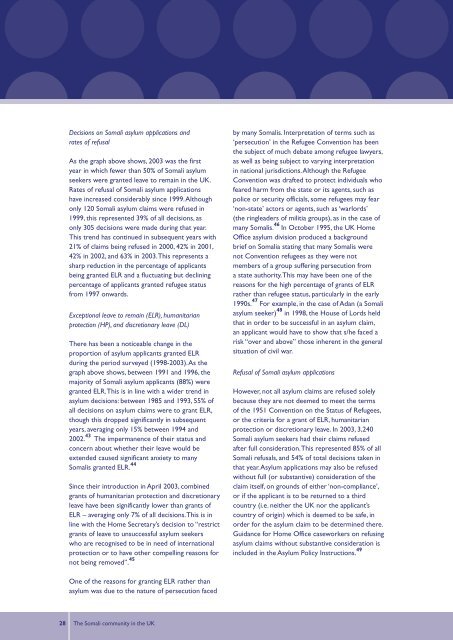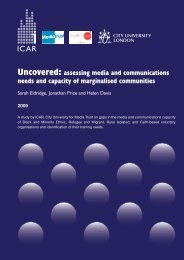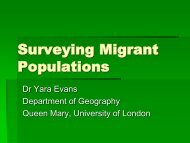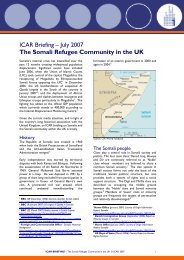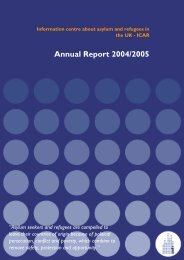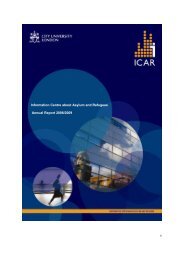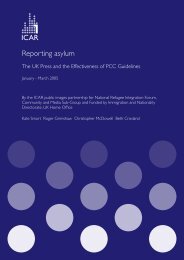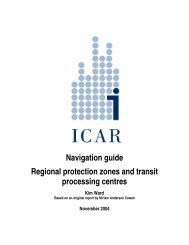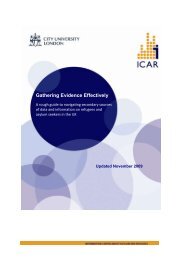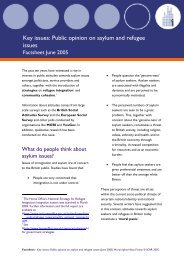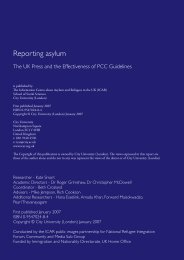The Somali community in the UK: What we know and how we ... - ICAR
The Somali community in the UK: What we know and how we ... - ICAR
The Somali community in the UK: What we know and how we ... - ICAR
You also want an ePaper? Increase the reach of your titles
YUMPU automatically turns print PDFs into web optimized ePapers that Google loves.
Decisions on <strong>Somali</strong> asylum applications <strong>and</strong><br />
rates of refusal<br />
As <strong>the</strong> graph above s<strong>how</strong>s, 2003 was <strong>the</strong> first<br />
year <strong>in</strong> which fe<strong>we</strong>r than 50% of <strong>Somali</strong> asylum<br />
seekers <strong>we</strong>re granted leave to rema<strong>in</strong> <strong>in</strong> <strong>the</strong> <strong>UK</strong>.<br />
Rates of refusal of <strong>Somali</strong> asylum applications<br />
have <strong>in</strong>creased considerably s<strong>in</strong>ce 1999. Although<br />
only 120 <strong>Somali</strong> asylum claims <strong>we</strong>re refused <strong>in</strong><br />
1999, this represented 39% of all decisions, as<br />
only 305 decisions <strong>we</strong>re made dur<strong>in</strong>g that year.<br />
This trend has cont<strong>in</strong>ued <strong>in</strong> subsequent years with<br />
21% of claims be<strong>in</strong>g refused <strong>in</strong> 2000, 42% <strong>in</strong> 2001,<br />
42% <strong>in</strong> 2002, <strong>and</strong> 63% <strong>in</strong> 2003. This represents a<br />
sharp reduction <strong>in</strong> <strong>the</strong> percentage of applicants<br />
be<strong>in</strong>g granted ELR <strong>and</strong> a fluctuat<strong>in</strong>g but decl<strong>in</strong><strong>in</strong>g<br />
percentage of applicants granted refugee status<br />
from 1997 onwards.<br />
Exceptional leave to rema<strong>in</strong> (ELR), humanitarian<br />
protection (HP), <strong>and</strong> discretionary leave (DL)<br />
<strong>The</strong>re has been a noticeable change <strong>in</strong> <strong>the</strong><br />
proportion of asylum applicants granted ELR<br />
dur<strong>in</strong>g <strong>the</strong> period surveyed (1998-2003). As <strong>the</strong><br />
graph above s<strong>how</strong>s, bet<strong>we</strong>en 1991 <strong>and</strong> 1996, <strong>the</strong><br />
majority of <strong>Somali</strong> asylum applicants (88%) <strong>we</strong>re<br />
granted ELR. This is <strong>in</strong> l<strong>in</strong>e with a wider trend <strong>in</strong><br />
asylum decisions: bet<strong>we</strong>en 1985 <strong>and</strong> 1993, 55% of<br />
all decisions on asylum claims <strong>we</strong>re to grant ELR,<br />
though this dropped significantly <strong>in</strong> subsequent<br />
years, averag<strong>in</strong>g only 15% bet<strong>we</strong>en 1994 <strong>and</strong><br />
2002. 43 <strong>The</strong> impermanence of <strong>the</strong>ir status <strong>and</strong><br />
concern about whe<strong>the</strong>r <strong>the</strong>ir leave would be<br />
extended caused significant anxiety to many<br />
<strong>Somali</strong>s granted ELR. 44<br />
S<strong>in</strong>ce <strong>the</strong>ir <strong>in</strong>troduction <strong>in</strong> April 2003, comb<strong>in</strong>ed<br />
grants of humanitarian protection <strong>and</strong> discretionary<br />
leave have been significantly lo<strong>we</strong>r than grants of<br />
ELR – averag<strong>in</strong>g only 7% of all decisions. This is <strong>in</strong><br />
l<strong>in</strong>e with <strong>the</strong> Home Secretary’s decision to “restrict<br />
grants of leave to unsuccessful asylum seekers<br />
who are recognised to be <strong>in</strong> need of <strong>in</strong>ternational<br />
protection or to have o<strong>the</strong>r compell<strong>in</strong>g reasons for<br />
not be<strong>in</strong>g removed”. 45<br />
by many <strong>Somali</strong>s. Interpretation of terms such as<br />
‘persecution’ <strong>in</strong> <strong>the</strong> Refugee Convention has been<br />
<strong>the</strong> subject of much debate among refugee lawyers,<br />
as <strong>we</strong>ll as be<strong>in</strong>g subject to vary<strong>in</strong>g <strong>in</strong>terpretation<br />
<strong>in</strong> national jurisdictions. Although <strong>the</strong> Refugee<br />
Convention was drafted to protect <strong>in</strong>dividuals who<br />
feared harm from <strong>the</strong> state or its agents, such as<br />
police or security officials, some refugees may fear<br />
‘non-state’ actors or agents, such as ‘warlords’<br />
(<strong>the</strong> r<strong>in</strong>gleaders of militia groups), as <strong>in</strong> <strong>the</strong> case of<br />
many <strong>Somali</strong>s. 46 In October 1995, <strong>the</strong> <strong>UK</strong> Home<br />
Office asylum division produced a background<br />
brief on <strong>Somali</strong>a stat<strong>in</strong>g that many <strong>Somali</strong>s <strong>we</strong>re<br />
not Convention refugees as <strong>the</strong>y <strong>we</strong>re not<br />
members of a group suffer<strong>in</strong>g persecution from<br />
a state authority. This may have been one of <strong>the</strong><br />
reasons for <strong>the</strong> high percentage of grants of ELR<br />
ra<strong>the</strong>r than refugee status, particularly <strong>in</strong> <strong>the</strong> early<br />
1990s. 47 For example, <strong>in</strong> <strong>the</strong> case of Adan (a <strong>Somali</strong><br />
asylum seeker) 48 <strong>in</strong> 1998, <strong>the</strong> House of Lords held<br />
that <strong>in</strong> order to be successful <strong>in</strong> an asylum claim,<br />
an applicant would have to s<strong>how</strong> that s/he faced a<br />
risk “over <strong>and</strong> above” those <strong>in</strong>herent <strong>in</strong> <strong>the</strong> general<br />
situation of civil war.<br />
Refusal of <strong>Somali</strong> asylum applications<br />
Ho<strong>we</strong>ver, not all asylum claims are refused solely<br />
because <strong>the</strong>y are not deemed to meet <strong>the</strong> terms<br />
of <strong>the</strong> 1951 Convention on <strong>the</strong> Status of Refugees,<br />
or <strong>the</strong> criteria for a grant of ELR, humanitarian<br />
protection or discretionary leave. In 2003, 3,240<br />
<strong>Somali</strong> asylum seekers had <strong>the</strong>ir claims refused<br />
after full consideration. This represented 85% of all<br />
<strong>Somali</strong> refusals, <strong>and</strong> 54% of total decisions taken <strong>in</strong><br />
that year. Asylum applications may also be refused<br />
without full (or substantive) consideration of <strong>the</strong><br />
claim itself, on grounds of ei<strong>the</strong>r ‘non-compliance’,<br />
or if <strong>the</strong> applicant is to be returned to a third<br />
country (i.e. nei<strong>the</strong>r <strong>the</strong> <strong>UK</strong> nor <strong>the</strong> applicant’s<br />
country of orig<strong>in</strong>) which is deemed to be safe, <strong>in</strong><br />
order for <strong>the</strong> asylum claim to be determ<strong>in</strong>ed <strong>the</strong>re.<br />
Guidance for Home Office caseworkers on refus<strong>in</strong>g<br />
asylum claims without substantive consideration is<br />
<strong>in</strong>cluded <strong>in</strong> <strong>the</strong> Asylum Policy Instructions. 49<br />
One of <strong>the</strong> reasons for grant<strong>in</strong>g ELR ra<strong>the</strong>r than<br />
asylum was due to <strong>the</strong> nature of persecution faced<br />
28 <strong>The</strong> <strong>Somali</strong> <strong>community</strong> <strong>in</strong> <strong>the</strong> <strong>UK</strong>


